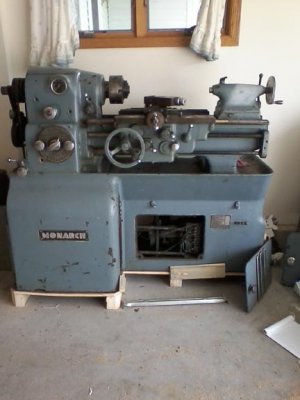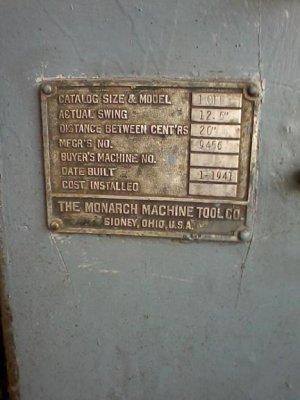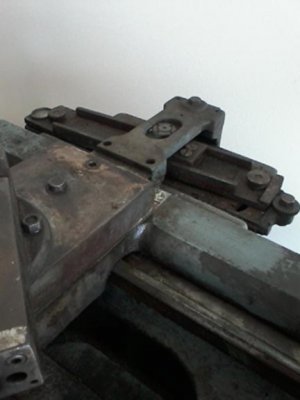-
Welcome back Guest! Did you know you can mentor other members here at H-M? If not, please check out our Relaunch of Hobby Machinist Mentoring Program!
You are using an out of date browser. It may not display this or other websites correctly.
You should upgrade or use an alternative browser.
You should upgrade or use an alternative browser.
Monarch 10EE
- Thread starter Walt
- Start date
- Joined
- Nov 16, 2012
- Messages
- 5,596
I wouldn't let tubes scare me off. If one burns out, it's just a matter of analyzing the circuit and replacing the tubes with FET's (Field Effect Transistors). I'm assuming the tubes are just power amplifiers and the gate Voltage is controlled by a rheostat. Easy shpeasy...
BTW: If anyone has the circuit diagram for those tubes, pass it my way and I'll convert it over to equivalent solid state components. You'll never know the difference except you won't have to wait for the tubes to warm up. -Tubes... Been a long time...
Ray
BTW: If anyone has the circuit diagram for those tubes, pass it my way and I'll convert it over to equivalent solid state components. You'll never know the difference except you won't have to wait for the tubes to warm up. -Tubes... Been a long time...
Ray
I have the schematic somewhere, it's not straightforward. It has active feedback to control speed under varying load. The tubes are called "thyratrons", and they handle an impressive amount of power without overloading. I'll see if I can track down my schematic. I know others have tried to build a solid state replacement for the thyratrons, but the consensus is that its a difficult enough problem that it's not worth solving while the cheap replacement tubes are still available. For reference, the original tubes are "C16J" and the cheap replacement tubes are "C6J". The 3hp machines originally shipped with C16Js, but they were overkill, and work fine with the C6Js.
- - - Updated - - -
Most of the older models use a DC motor for the spindle. Older models used a generator to create the DC field, the "Works in a drawer" models used an electron tube controller, with a pair of large tubes called "thyratrons" (described above) to produced rectified AC. They then switched to a solid state drive, and then to a VFD ultimately. These machines have been in production for quite a while in more or less the same form factor, with an update to the drive electronics once a decade or so.
- - - Updated - - -
I would have a couple of questions about the valve tubes are they acting as a VFD, I'm sure that's the only technology they had at the time of the machine being made but a little digging on the Internet you should be able to go to standard variable frequency drive control. But hey use them till they wear out.
PS I would remove them for shipment.
Most of the older models use a DC motor for the spindle. Older models used a generator to create the DC field, the "Works in a drawer" models used an electron tube controller, with a pair of large tubes called "thyratrons" (described above) to produced rectified AC. They then switched to a solid state drive, and then to a VFD ultimately. These machines have been in production for quite a while in more or less the same form factor, with an update to the drive electronics once a decade or so.



I went to the owner's home today and looked at the 10EE. It's a 1941 model, I think that makes it a motor-generator drive. The name plate says it's a "Catalog Size & Model 1-OFF".
It's relatively rust free and doesn't have any obvious problems with cracks or dings in the ways. The gears in the head have oil in the bath and no signs of leaks. As I suspected, the owner never got it running. I spun the chuck and didn't hear any grinding. Put a $200 deposit down. Now to figure out how to move it!
Walt



Last edited:
The nameplate states: '10"EE', nominally a 10" by 20" "sensitive" lathe.
For early machines, the actual swing is 2.0" larger than the nameplate states.
So, a 12.0" by 20" lathe.
For later machines the actual swing is 2.5" larger than the nameplate states (as is also true of most other Monarch lathes).
So, a 12.5" by 20" lathe.
This explains that the model number on the nameplate was hand stamped and that's why it reads funny. Definitely a model 10EE.
Walt
For early machines, the actual swing is 2.0" larger than the nameplate states.
So, a 12.0" by 20" lathe.
For later machines the actual swing is 2.5" larger than the nameplate states (as is also true of most other Monarch lathes).
So, a 12.5" by 20" lathe.
This explains that the model number on the nameplate was hand stamped and that's why it reads funny. Definitely a model 10EE.
Walt
Last edited by a moderator:
- Joined
- Jan 22, 2011
- Messages
- 8,031
I'd certainly do it. I'm fond of tube equipment anyway, but either way, that is or can be a nice machine.
Yeah, I think 41 would be a motor/generator arrangement (no tubes, I think they used a rheostat to control the field strength on the generator). Looks like you got a taper attachment (or at least part of one) which is a nice feature. Other than some gunk, and a little surface rust, it seems in good shape. You might make out ok on this one  .
.
One thing I forgot to mention is that, while it takes standard chucks (D1-3 IIRC), the spindle taper is wierd (Jarno, can't recall what size). They shipped with a Jarno to MT2 adapter. You might casually ask if he has it lying around. That is if you ever intend to use a center in the headstock. Tailstock should be a standard MT2.
One thing I forgot to mention is that, while it takes standard chucks (D1-3 IIRC), the spindle taper is wierd (Jarno, can't recall what size). They shipped with a Jarno to MT2 adapter. You might casually ask if he has it lying around. That is if you ever intend to use a center in the headstock. Tailstock should be a standard MT2.
Yeah, I think 41 would be a motor/generator arrangement (no tubes, I think they used a rheostat to control the field strength on the generator). Looks like you got a taper attachment (or at least part of one) which is a nice feature. Other than some gunk, and a little surface rust, it seems in good shape. You might make out ok on this one.
One thing I forgot to mention is that, while it takes standard chucks (D1-3 IIRC), the spindle taper is wierd (Jarno, can't recall what size). They shipped with a Jarno to MT2 adapter. You might casually ask if he has it lying around. That is if you ever intend to use a center in the headstock. Tailstock should be a standard MT2.
I've asked for extra parts once, but asking twice might jar a cobweb loose. You never know.
I think you are right about that mystery part photo being an incomplete taper attachment.
The story from yesterday is the current owner is a tool & die pro who picked the Monarch up from a machinery dealer who was getting out of the business. He was having a "fire sale" (maybe health or money problems?), and this was the dealer's baby that he was planning to restore for himself and consequently, the last machine to go.
- Joined
- Nov 16, 2012
- Messages
- 5,596
Walt, you're getting pretty close to qualifying for a big "you suck" award... :thumbsup:
1941... You can only imagine what parts it made to support the war effort!
Good luck with the rest of the transaction and move. Keep us tied-in.
Ray
1941... You can only imagine what parts it made to support the war effort!
Good luck with the rest of the transaction and move. Keep us tied-in.
Ray

